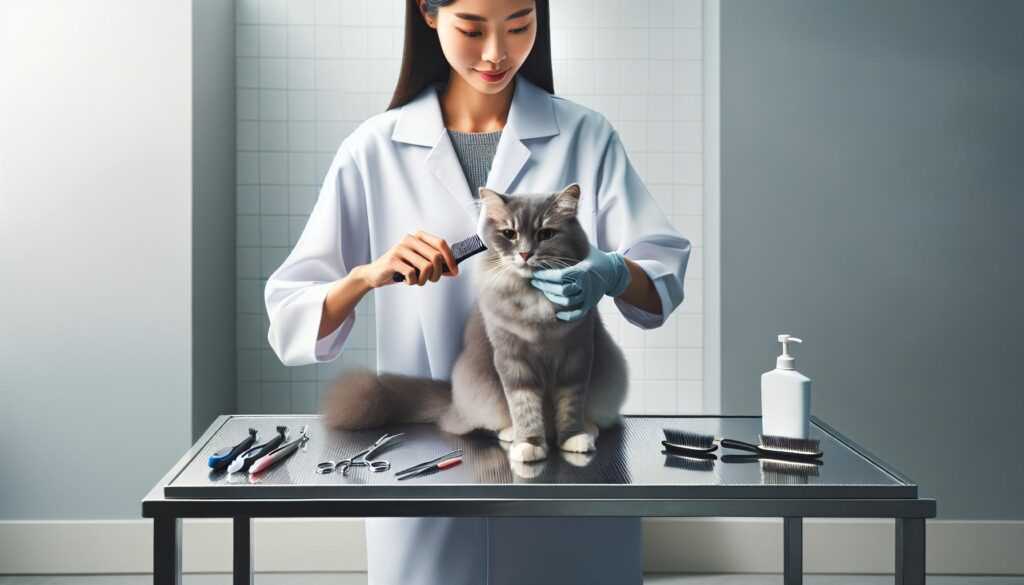Cats are known for their impeccable grooming habits, but what happens when your feline friend starts scratching incessantly or develops unsightly skin issues? It’s not just a cosmetic concern; it’s a sign that your pet’s health may be at risk.
Understanding cat skin problems is crucial for any cat owner. From allergies to parasites, a variety of factors can disrupt your cat’s skin health. Armed with the right knowledge, you’ll be better equipped to spot the signs early and seek the necessary treatment.
Whether it’s a simple rash or something more serious, getting to the root of the problem is key. Stay tuned as we delve into the common skin conditions affecting cats and how you can help your furry companion stay comfortable and healthy.
Common Cat Skin problems
If your cat’s been itching more than usual or you’ve spotted some changes in their coat, they might be facing one of several common skin problems. Identifying these issues early can make a significant difference in your cat’s comfort and health.
Flea Allergy Dermatitis is a leading cause of skin problems in cats. Even a single flea bite can trigger an intense allergic reaction, causing severe itching and skin inflammation. You’ll often notice your cat scratching frantically, leading to hair loss and secondary skin infections.
Mites and Ringworm, although less common, are highly contagious. Mites, such as the ones causing scabies, lead to mange, which is characterized by skin redness and scaly patches. Ringworm, a fungal infection, presents as circular, bald patches on your cat’s skin.
Food Allergies can also manifest through your cat’s skin, resulting in itchiness, especially around the head and neck. Identifying the specific allergen through an elimination diet can be a tedious but necessary process.
It’s imperative to pay attention to:
- Excessive scratching or grooming
- Hair loss or thinning fur
- Red, inflamed, or scabby skin
- Bald patches or sores
These signs warrant a trip to the vet to pinpoint the cause and begin appropriate treatment. Ongoing care typically involves topical treatments, oral medications, and sometimes dietary adjustments.
Causes of Cat Skin Problems
Cat skin problems can arise from various sources, ranging from environmental factors to more intrinsic health issues. Understanding these causes is crucial for maintaining your cat’s skin health and overall wellbeing. Let’s delve into some of these common provocateurs.
Allergies
Cats, much like humans, can suffer from allergies that affect their skin. Allergenic triggers may include:
- Pollen
- Mold
- Dust mites
- Certain foods
When cats come into contact with these allergens, it can lead to a condition known as atopic dermatitis. This type of dermatitis causes the immune system to overreact, leading to skin inflammation, itching, and discomfort. Observing your cat’s responses to changes in their environment or diet can help pinpoint potential allergens. Additionally, your vet might recommend allergy tests to identify the specific triggers.
Infections
Bacterial and fungal infections can also lead to skin problems in cats. Ringworm, a common fungal infection named for its characteristic ring-shaped rash, is particularly infectious and can spread to humans and other pets. Bacterial infections, often secondary to a wound or allergy, can cause pyoderma – resulting in pus-filled lesions on the skin.
Signs of infections can manifest as:
- Pustules
- Dry, flaky skin
- Ulcerations
- Hair loss in circular patches
Prompt treatment with antifungal or antibiotic medications is vital to prevent further complications. Always consult with your vet for the most appropriate treatment plan tailored to your cat’s specific condition.
Parasites
Finally, skin issues in cats can frequently be traced back to parasites. Fleas are notorious for causing irritation, leading to flea allergy dermatitis – the most common allergic skin disease in cats. Moreover, mites can cause conditions such as scabies or ear mites, characterized by intense scratching and inflammation.
External parasites that commonly affect cats include:
- Fleas
- Mites
- Ticks
They are not just a nuisance but can also transmit diseases. Keeping your cat on a regular parasite prevention program is a key step in safeguarding them against these pests. Regular grooming and environmental control measures also play important roles in parasite management.
Symptoms of Cat Skin Problems
Itching and Scratching
If you’ve noticed your cat seems to be itching more than usual, it could be a sign of a skin problem. Excessive scratching can be a direct response to irritants on the skin such as allergens, fungal infections, or parasitic infestations. This incessant need to scratch can lead to more severe issues if not addressed. Your cat might develop sores or hot spots where the skin has been worn away, which can become vulnerable to secondary infections.
Hair Loss
Hair loss, or alopecia, in cats is often a clear indicator of skin health issues. While some shedding is normal, patchy or extensive hair loss is not and warrants closer attention. You might observe bald spots or thinning of the fur in certain areas. Parasites like fleas and mites are common perpetrators, but allergies and infections can also disrupt the natural growth cycle of your cat’s fur, causing hair to fall out.
Redness and Inflammation
Visible changes in your cat’s skin, particularly redness and swelling, are telltale signs of an underlying problem. Red, inflamed skin can be painful for your cat and is often a reaction to an irritant or infection. Inflammation can manifest alongside other symptoms like scaling, crusting, or even oozing of pus from affected areas. Immediate attention to these symptoms can prevent progression and aid in a quicker recovery for your feline friend.
Diagnosing Cat Skin Problems
Veterinary Examination
When you notice any skin irregularities on your cat such as itching, scratching, or redness, the first step is to book a consultation with your vet. A thorough veterinary examination is crucial in identifying the root of the skin problem. During the visit, your vet will ask about your cat’s medical history, diet, and recent activities. A physical inspection of the skin, from the ears to the tail, will help pinpoint specific symptoms and affected areas. Understanding your cat’s environment and routine can offer insight into potential causes of skin irritation.
Skin Scraping Test
To get a definitive diagnosis, your vet might conduct a skin scraping test. This involves collecting skin cells from the surface of your cat’s skin. The procedure is straightforward and provides valuable information. The sample is examined under a microscope to check for parasites like mites or any fungal infections. Skin scraping results are often available quickly, enabling prompt treatment options. It’s a reliable method to distinguish between conditions that might have similar symptoms, such as mange, ringworm or dermatitis.
Allergy Testing
Just like humans, cats can develop allergies to a variety of substances. If your vet suspects allergies are causing the skin issues, they may suggest allergy testing. There are different types of allergy tests:
- Intradermal skin testing: Small amounts of common allergens are injected into the skin to observe reactions.
- Serological testing: This blood test measures the level of antibodies against potential allergens.
Whichever method is used, allergy testing can be an invaluable tool in establishing an effective treatment plan. By understanding what your cat is allergic to, you can take active steps in reducing exposure to the allergen and tailor a dietary or medicinal approach that addresses the specific sensitivity.
Treating Cat Skin Problems
Once your vet has determined the cause of your cat’s skin problems, they’ll devise a treatment plan targeted to provide relief and address the underlying issue. Treatments can vary widely depending on the diagnosis and may include topical and oral medications as well as dietary changes.
Topical Medications
For issues like parasites, fungal infections, or localized inflammatory conditions, topical treatments often provide immediate relief. These can include:
- Medicated shampoos that cleanse the skin and contain ingredients to combat specific pathogens or soothe irritation
- Antiparasitic solutions, often applied as drops on the neck, to eradicate pests such as fleas or mites
- Creams and ointments with corticosteroids to reduce inflammation and allergic reactions
Follow your vet’s instructions closely when applying these medications, as overuse or misuse can lead to further complications.
Oral Medications
In some cases, topical treatments aren’t sufficient, and your vet might prescribe oral medications, which may be:
- Antibiotics, if a bacterial infection is present
- Antifungals, for conditions like ringworm
- Steroids to decrease severe inflammation
- Immunosuppressive drugs for certain autoimmune conditions
It’s crucial to ensure your cat completes the full course of any prescribed oral medication to prevent recurrence or resistance.
Dietary Changes
Food allergies are a common cause of skin issues in cats. Identifying and eliminating the offending ingredients can substantially improve your cat’s skin health. Consider the following:
- Transitioning to a hypoallergenic diet under veterinary guidance
- Omega-3 and Omega-6 fatty acid supplements which can improve skin barrier function and reduce inflammation
- Incorporating novel protein sources your cat hasn’t been exposed to can help pinpoint allergies
Consistency with dietary changes is key. It often takes several weeks to notice an improvement in your cat’s skin condition. Keep in regular contact with your vet to monitor progress and adjust the treatment plan as needed.
Preventing Cat Skin Problems
Preventative measures are key when it comes to your cat’s skin health. A proactive approach can significantly reduce the risk of dermatological issues developing or recurring. In this section, you’ll learn how to integrate effective prevention strategies into your cat’s care routine.
Regular Grooming
Grooming is more than just keeping your cat looking their best; it’s vital for maintaining healthy skin. Brushing your cat regularly helps to remove dirt, dandruff, and loose hair that can contribute to skin irritation. For long-haired breeds, it also prevents matting, which can lead to skin infections.
- Aim to brush your cat several times a week.
- Use a brush suitable for your cat’s hair type.
- Inspect your cat’s skin for signs of problems during grooming sessions.
Regular ear checks and nail trims should also be part of the routine, as overgrown nails can cause scratches that lead to infection, and dirty ears are prone to mites and bacterial growth.
Balanced Diet
Your cat’s diet plays a significant role in their skin health. Feeding your cat a well-balanced, high-quality diet can support skin elasticity and integrity. Look for foods rich in:
- Omega-3 and Omega-6 fatty acids.
- Antioxidants.
- High-quality proteins.
These nutrients work together to reduce inflammation and promote healthy skin and coat. If your cat has food sensitivities, consult your vet about hypoallergenic or limited-ingredient diets, which may help prevent allergic reactions that affect the skin.
Environmental Changes
Sometimes the environment contributes to skin problems in cats. A few changes around your home can make a big difference:
- Use hypoallergenic detergents for bedding.
- Avoid exposure to cigarette smoke and other irritants.
- Consider using a humidifier in dry conditions.
Additionally, minimizing stress through environmental enrichment can reduce the occurrence of psychogenic dermatitis. This involves providing:
- Adequate play opportunities.
- Sufficient litter trays.
- Safe resting spots.
By altering these aspects of your cat’s environment, you can minimize external factors that may lead to skin issues.
Conclusion
Your cat’s skin health is crucial for their overall well-being. By taking proactive steps, you’ll not only help prevent common skin problems but also enhance your furry friend’s quality of life. Remember, regular grooming and a nutritious diet are your best allies in this endeavour. Stay vigilant for any signs of skin distress and don’t hesitate to seek veterinary guidance when needed. Your commitment to your cat’s skin care routine will pave the way for a happier, healthier companion.
Frequently Asked Questions
What causes skin problems in cats?
Skin problems in cats can be caused by a variety of factors including parasites, allergies, infections, hormonal imbalances, and stress.
How can regular grooming help prevent cat skin problems?
Regular grooming such as brushing, ear checks, and nail trims helps maintain healthy skin by removing debris, mats, and parasites that may cause irritation or infections.
Are dietary factors important for cat skin health?
Yes, a balanced diet rich in omega-3 and omega-6 fatty acids, antioxidants, and high-quality proteins is essential for supporting healthy skin in cats.
How can environmental changes prevent cat skin issues?
Making environmental changes such as using hypoallergenic detergents and reducing exposure to irritants can help prevent skin problems in cats by minimizing potential allergic reactions or sensitivities.






